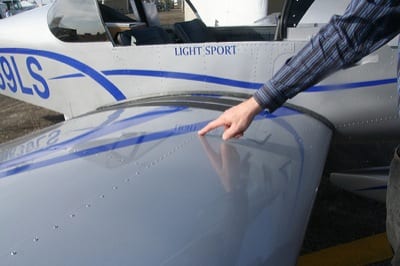
Several factors, including a wing structure that does not meet ASTM standards for Light Sport Aircraft, are indicated as causes for Zodiac CH601XL and CH650 in-flight accidents, according to an FAA report released Feb. 22.
The special report is the result of an investigation into the Zodiacs after a series of in-flight structural failures, which led the agency to stop issuing airworthiness approvals late last year. The LSAs are available fully built from Aircraft Manufacturing and Design Inc. (AMD) and as amateur-built kits from Zenith Aircraft.
The FAA’s investigation did not indicate a single root cause for the in-flight failures, but implicated the potential combination of several design and operation aspects. An important finding in the FAA study was that the wing structure did not meet the approved ASTM International standards to handle the required loads and stresses for a 1,320-pound aircraft. The FAA report also identified issues with the airplane’s flutter characteristics, airspeed calibration, stick force gradients and operating limitations.
The aircraft manufacturers have developed modifications for the Zodiac wing structure. Those modifications were made willing, according to Mathieu Heintz, vice president and son of Chris Heintz, the designer of the Zodiac, who noted the company went above and beyond the recommendations of the FAA.
“A lot of work went into this,” he said. “The FAA did their own internal investigation, the NTSB did their own, and we did ours. The FAA wanted a few things to change on the airplane, but we felt that what they were recommending was not enough for our customer base, so we did significantly more than what they wanted.”
The modification package is designed to strengthen the airplane by over-building the wing spars and adding aileron counter-balance. The upgrade costs approximately $300.
 “We’re losing money on every package, but we want our customers to do this,” Heintz said. “We strongly believe that implementation of the comprehensive Upgrade Package kit, combined with continuing pilot education and training, as well as an ongoing airworthiness and maintenance program, will put an end to the type of tragic accidents that have been happening and restore this aircraft’s reputation as a capable and fun light sport aircraft.”
“We’re losing money on every package, but we want our customers to do this,” Heintz said. “We strongly believe that implementation of the comprehensive Upgrade Package kit, combined with continuing pilot education and training, as well as an ongoing airworthiness and maintenance program, will put an end to the type of tragic accidents that have been happening and restore this aircraft’s reputation as a capable and fun light sport aircraft.”
For more information: ZenithAir.com or NewPlane.com.

Yeah, Steve, that’s the typical “solution” to problems nowadays (lawsuit time). It’s the American way! Yeah, let’s put another company (and potentially industry) out business… This company has been fixing the not-so-obvious problem (and offering the upgrade to the hundreds of non SLSA homebuilts as well) and working with customers to remedy the situation (and not make it worse). Importantly, they’re still in business to support them. How would suing a small company out of existence help the owners? Based on my observations if the FAA were to study all SLSAs out there it would also report that most (if not all) do not meet the ASTM standards in one way or another. Lawsuit time, right?
“An important finding in the FAA study was that the wing structure did not meet the approved ASTM International standards to handle the required loads and stresses for a 1,320-pound aircraft”
It’s lawsuit time for anyone who purchased the SLSA version of this aircraft. While representing the aircraft as ASTM compliant, they instead sold one that was not. Either AMD fixes every SLSA for free to bring it into compiance with ASTM, or they better dust off their lawyers and suit them up for trial.